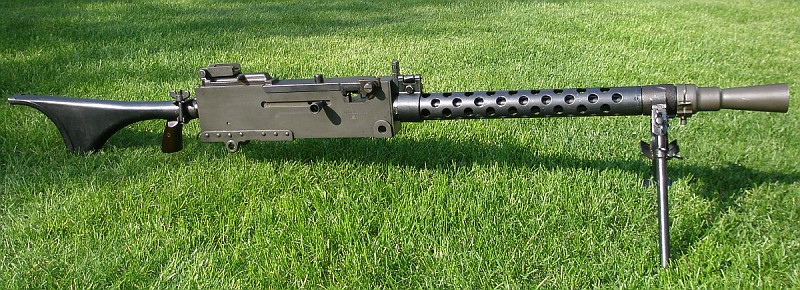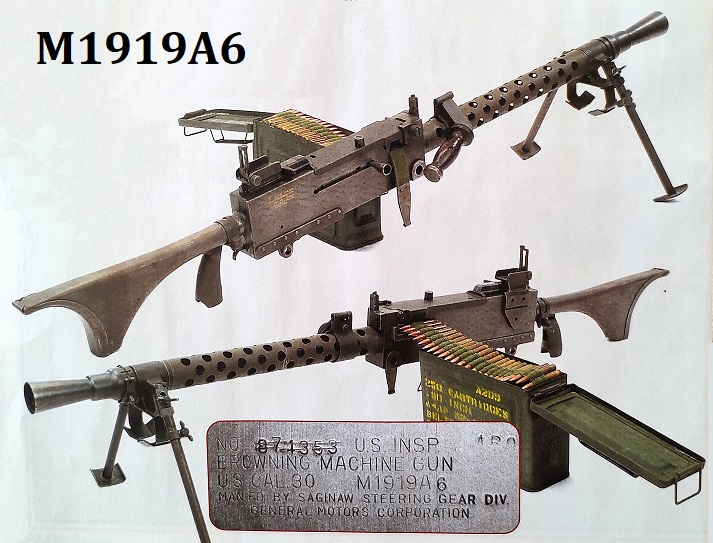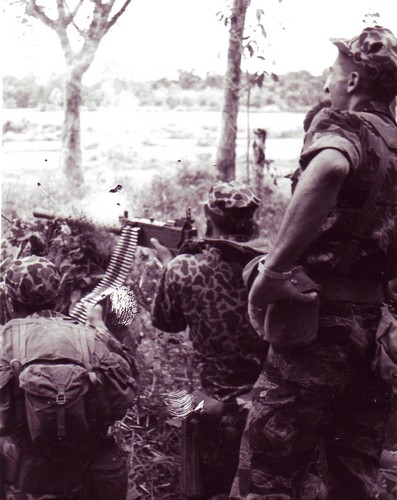M1919A6
| Factions | Weapon | Icon | Classes | Ammo |
|---|---|---|---|---|
 US |
 M1919A6 |
 |
150 / 300 |
| Damage Base | Headshot × | Chest × | Stomach × | Leg × | Arm × | Bayonet | Rifle Grenades | Reload Speed | |
|---|---|---|---|---|---|---|---|---|---|
| Partial | Empty | ||||||||
| 47 | ×2.4 = 112.8 | ×1.3 = 61.1 | ×1.25 = 58.75 | ×0.8 = 37.6 | ×0.75 = 35.25 | NO | NO | 4.833 Seconds | 5.66 Seconds |
| Designation | Weapon Type | Fire Modes | Fire Rate | Bullet Spread ° | Bipod Bullet Spread ° | Range Modifier | Muzzle Velocity | Projectile weight | Weight |
|---|---|---|---|---|---|---|---|---|---|
| M1919A6 | LMG | Auto | 450 RPM | 10.83° & 2.55° ADS | 2.48° & 0.58° ADS | 0.925 | 800 m/s | 9g (138.89 gr) | 15 kg (33 lbs) |
| Full name | Caliber | Place of Origin | Date | Manufacturer | Barrel Length | Total Length | Weapon Script Name |
|---|---|---|---|---|---|---|---|
| Machine Gun, Caliber .30, Browning, M1919 | .30-06 | USA | 1943 | Buffalo Arms Corporation Rock Island Arsenal Saginaw Steering Gear |
24 in (610 mm) | 53 in (1,346 mm) | weapon_m1919a6 |
The M1919 Browning is a .30 caliber medium machine gun that was widely used during the 20th century, especially during World War II, the Korean War, and the Vietnam War. The M1919 saw service as a light infantry, coaxial, mounted, aircraft, and anti-aircraft machine gun by the U.S and many other countries.
HISTORY
The M1919 was an air-cooled development of the standard US machine gun of World War I, the John M. Browning-designed water-cooled M1917. The emergence of general-purpose machine guns in the 1950s pushed the M1919 into secondary roles in many cases, especially after the arrival of the M60 in US Army service. The United States Navy also converted many to 7.62 mm NATO and designated them Mk 21 Mod 0; they were commonly used on riverine craft in the 1960s and 1970s in Vietnam.
During WWII, the US military recognized the limitations of the M1918 Browning Automatic Rifle for sustained fire, due to its fixed barrel and limited magazine capacity. In response, they developed the M1919A6 as a temporary solution, adapting existing designs to try to match the portability and efficiency of German MG 34 and MG 42 machine guns. The M1919A6, introduced in combat in late 1943, featured a removable metal buttstock, a lighter barrel with a carrying handle, and a front-loaded barrel change system that, although an improvement, was still cumbersome. Despite these modifications, the M1919A6, weighing 32 pounds, was heavier and more awkward than its German counterparts and was eventually phased out for the lighter M60 machine gun in the 1960s.
SOURCE
-
A Special Forces machine gunner fires a Browning M1919 at a group of Việt Cộng insurgents on the edge of the Ap Suoi Tre rubber plantation in war zone “D”, north of Ben Cat (III Corps). Photo taken: November 1964
-
Vietnamese soldier training with a Browning M1919





